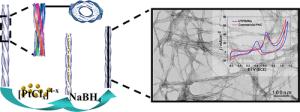
A team led by Faming Gao of Yanshan University in China has published their work detailing the use of insulin amyloid fibrils (INSAFs) to control synthesis of ultrathin platinum nanowires (UTPtNWs) with a diameter of circa 1.8 nm and an aspect ratio of at least 104 in the most recent issue of J. Am. Chem. Soc. (Title: Insulin Amyloid Fibrils: An Excellent Platform for Controlled Synthesis of Ultrathin Superlong Platinum Nanowires with High Electrocatalytic Activity, see below).
This is the first report in the world that single-crystalline Pt nanowires have been synthesized with such thin diameters and superhigh aspect ratios.
The platinum nanostructures have been exploited to use in catalysis, petrochemical industry, and fuel cells, etc.
The production of Pt catalyst with great catalytic performance and utilization efficiency, however, is still costly and far from trivial. A growing demand recently for efficient, low-cost renewable energy has sparked great scientific interest in the development of materials for electrocatalysts. One-dimensional Pt NWs can provide a great opportunity to increase their activity and improve their catalytic properties on a mass basis, because they possess fewer defect sites, fewer lattice boundaries, and higher numbers of surface atoms.
In this sense, the UTPtNWs with superhigh aspect ratios will play an important role in the next-generation electrocatalysts.
Faming Gao and his co-workers creatively used INSAFs as sacrificial templates to synthesize the UTPtNWs. The as-prepared UTPtNWs exhibited attractive electrocatalytic behavior toward methanol oxidation reaction due to the preferential exposure of certain crystal facets and/or to the presence of fewer surface defects on the UTPtNWs, which is 18% higher than that for the commercial Pt/C catalyst. The UTPtNWs also maintained excellent electrochemical durability under repeated cyclic voltammetry scans.
The use of UTPtNWs as catalysts should open new and exciting possibilities for enhancing the performance of electrochemical activity, and greatly decrease the amounts of Pt and cut down the cost in the applications.
This nanostructure may also be of vital significance and importance in sensing, biomedical, and other electrochemical applications.
Further Information:
Longgai Zhang, Na Li, Faming Gao, Li Hou, and Ziming Xu:
Insulin Amyloid Fibrils: An Excellent Platform for Controlled Synthesis of Ultrathin Superlong Platinum Nanowires with High Electrocatalytic Activity.
In: Journal of the American Chemical Society; J. Am. Chem. Soc., 134 (28), pp 11326 - 11329, publication date June 28, 2012, DOI 10.1021/ja302959e
Source: Faming Gao, personal notification.
Last update: 06.08.2012
Perma link: https://www.internetchemistry.com/news/2012/aug12/ultrathin-superlong-platinum-nanowires.php
More chemistry: index | chemicals | lab equipment | job vacancies | sitemap
Internetchemistry: home | about | contact | imprint | privacy
© 1996 - 2023 Internetchemistry
